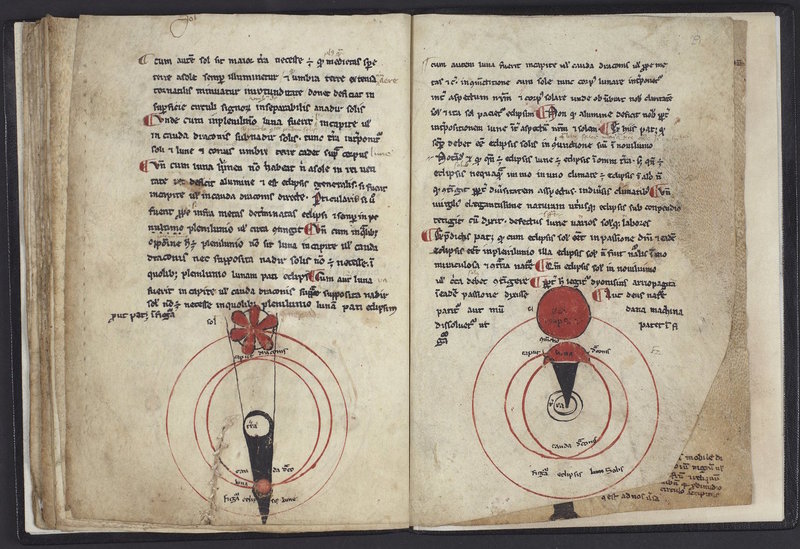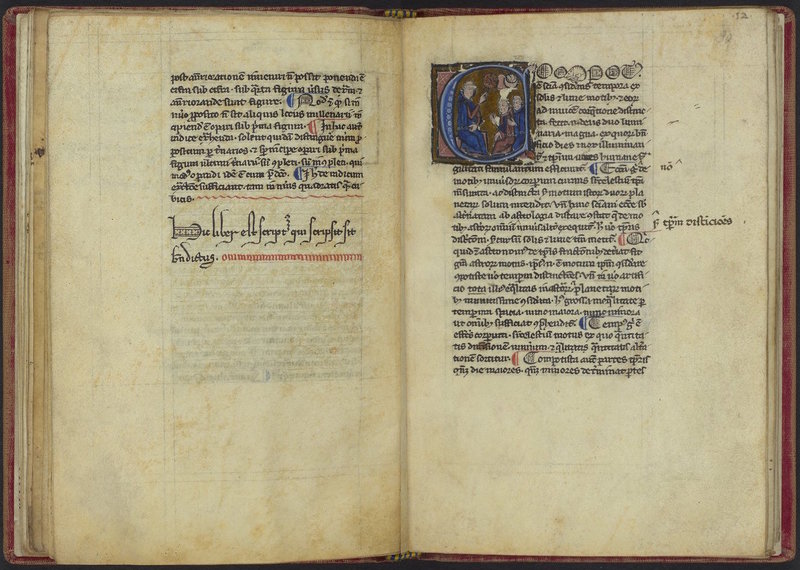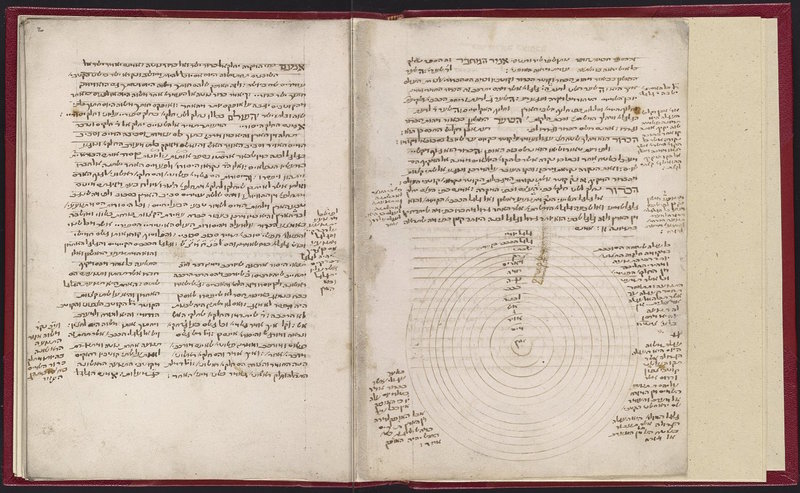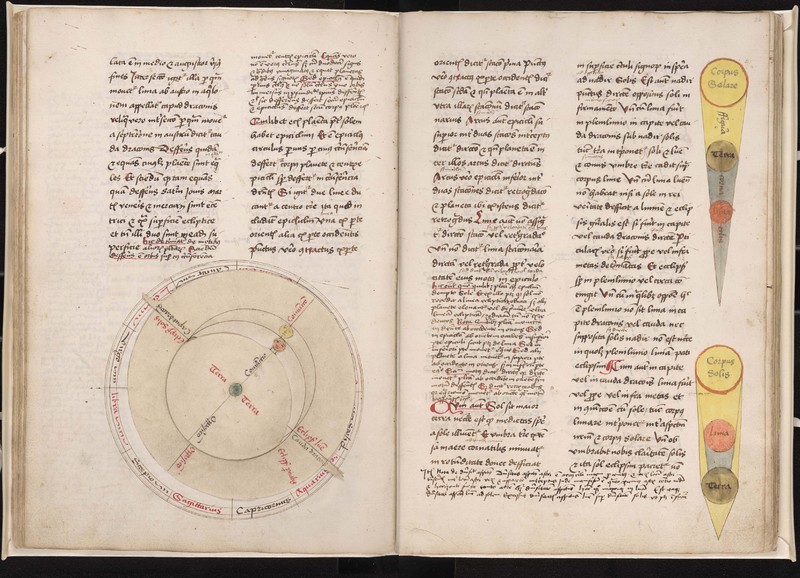Sacrobosco
Johannes de Sacrobosco (c. 1195-c. 1256), Algorismus, Tractatus de sphaera. Italy, c. 1225-1275. LJS 26, parchment, in Latin. Fols. 28v-29r.
The Tractatus de sphaera (or De sphaera mundi) was arguably the most important Latin medieval text on Ptolemaic astronomy. Likely a composite of information from the Almagest, Arabic commentaries by al-Battānī and al-Farghānī, and earlier Latin sources such as Macrobius, this widely disseminated university text described the division of the “sphere of the world” above the Earth into nine parts: the primum mobile (“first moved”), fixed stars, planets, sun, and moon.
The Kislak Center owns four copies of the Tractatus, two of which (LJS 26 and LJS 216) were produced during or soon after Sacrobosco’s lifetime. Like LJS 216, this manuscript also contains Sacrobosco’s Algorismus, a practical arithmetic manual that was the first text to use Hindu-Arabic numerals in a European scholastic context. The Tractatus contains eleven diagrams and illustrations, which include the celestial spheres, the Earth’s climatic zones, the motion of the sun and moon, and eclipses (on display). There are marginal notes in the same ink as the main text, as well as notes and an added bifolium in a later cursive hand (fols. 23-24). An annotation dated 1399 indicates that this manuscript was used by Pietro di Santo Giovanni, a physics student in Florence (fol. 9v).
Johannes de Sacrobosco (c. 1195-c. 1256), Tractatus de sphaera, Algorismus, Computus lunaris. Paris (?), c. 1256-1270. LJS 216, parchment, in Latin. Fols. 28v-29r.
This striking manuscript includes three historiated initials that have been linked to the style of the Bari workshop in Paris (1250-70), all showing Sacrobosco teaching astronomy to tonsured students (fols. 1r, 29r, 43v). In addition to the diagrams of eclipses and solar and lunar motion that it shares with LJS 26, as well as a richly colored diagram of the Earth’s climates (fol. 16v), it also contains a circular table of solar conjunctions (fol. 40r) and an ouroboros (fol. 36r). The third text in this volume describes the computation of civil and ecclesiastical calendars.
Little is known about Sacrobosco’s life apart from his tenure as a professor of mathematics at the University of Paris, beginning in the 1220’s. He may have been born in Holywood, Yorkshire, and he was known during his lifetime for criticizing the imprecise Julian calendar, which had developed a total error of about ten days by the late thirteenth century.
Johannes de Sacrobosco (c. 1195-c. 1256), Tractatus de sphaera; Yehudah ibn Tibon (c. 1120-c. 1190), Ruaḥ Ḥen (attributed). Northern Italy, c. 1425-1450. LJS 494, paper, in Hebrew. Fols. 1v-2r.
This is one of approximately forty copies of the only known Hebrew version of the Tractatus de sphaera, which was translated as Mareh ha-Ofanim (The Indicator of the Spheres)by the Provençal physician and mystic Solomon ben Abraham Abigdor (b. 1384; translation completed 1399). Although less ornate than the thirteenth-century copies in the Schoenberg collection, this manuscript includes three diagrams, the largest of which (shown here) depicts the celestial and elemental spheres. This codex also includes Ruaḥ Ḥen (fols. 12r-22r), a popular thirteenth-century introduction to Aristotelian science, which it attributes to Yehudah ibn Tibon.
Gerard de Sabloneta (13th c., attributed), Theorica planetarum; Johannes de Sacrobosco (c. 1195-c. 1256), Tractatus de sphaera; John of Saxony (c. 1300-1380), Canones tabularum regis Alphonsii; and other texts. Southeastern Germany, c. 1481. MS. Codex 1881, paper, in Latin with a few Hebrew words. Fols. 35v-36r.
This extensively glossed astronomical miscellany was acquired by the Kislak Center in 2017. It contains a selection of popular pedagogical and practical texts, including the Theorica planetarum (the basis for Peuerbach’s Theoricae novae planetarum), Sacrobosco’s Tractatus de sphaera, and the Alfonsine Tables. However, this manuscript’s late date of production, after the birth of Copernicus and the first printed edition of Sacrobosco's text, points to the transience of its educational value.
This codex contains six volvelles, including larger ones depicting planetary movements as well as small, marginal volvelles illustrating geometric principles. Many pages are painstakingly annotated, including a climate zone diagram with place names written into the appropriate zones (fol. 33v). The Tables have calculations added in the bottom margins for specific cities, mostly in Germany, and the Tractatus de sphaera concludes with a colophon dated 30 December 1481 (fol. 36v). On the final leaf are a Hebrew alphabet and a reference to Magdeburg (fol. 95v).



